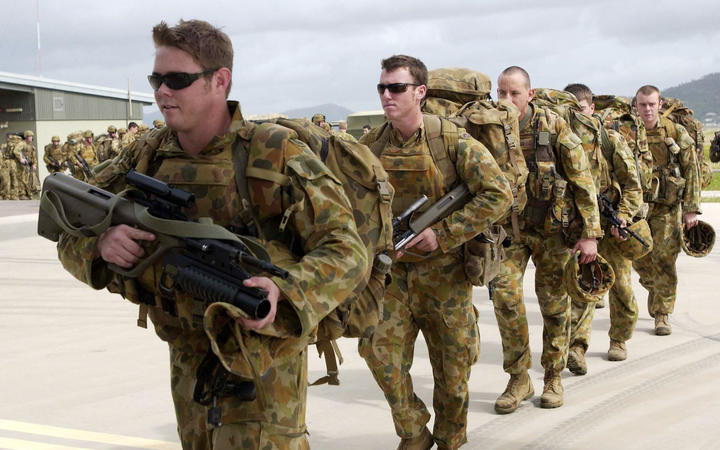Australia’s military will move towards a wartime footing under government plans to boost the number of uniformed personnel to almost 80,000 by 2040, amid strategic risks posed by China and Russia.
 The expansion will see 18,500 more uniformed defence personnel (file picture). Photo: AFP / Australian Department of Defence
The expansion will see 18,500 more uniformed defence personnel (file picture). Photo: AFP / Australian Department of Defence
The proposed $38 billion expansion would see the full-time Australian Defence Force grow to a size not seen since the Vietnam War, requiring its biggest recruitment effort in 40 years.
Under the massive expansion to be unveiled by Prime Minister Scott Morrison and Defence Minister Peter Dutton at Brisbane’s Gallipoli Barracks on Thursday, the total number of Defence employees, including civilians, would rise to more than 101,000.
According to the government, the additional 18,500 uniformed personnel is 6000 more than the “critical minimum” recommended by Defence to provide “redundancy and resilience”, that is to cover casualties from armed conflict.
It says the personnel numbers are in line with the direction of the 2020 Force Structure Plan (FSP), and detailed planning has been underway since the National Security Committee of cabinet approved the policy last November.
More soldiers, sailors and aviators are needed to operate new military capability, including promised nuclear-powered submarines, Hunter-class frigates and advanced long-range and defensive missile systems.
Emerging battlefront domains such as space, information and cyber warfare are also a focus of the planned expansion of the Australian Defence Force (ADF).
Against the backdrop of war in Ukraine and growing tensions with China, Morrison has identified national security as a key battleground for his re-election bid, arguing the “first priority of my government is to keep Australians safe”.
“To do that we need a bigger ADF with more soldiers, sailors and airmen and women to operate the cutting-edge capabilities we’re getting to protect Australia,” Morrison said.
“You can’t flick a switch to increase your army, navy and air force overnight. Growing the type of people and skills we need to face the threats of the future takes time, so we must start now so critical skills can be taught and experience gained.”
Dutton said the massive workforce boost was needed to build a credible military force that could protect Australia’s strategic interests.
“This growth in workforce and expertise will enable us to deliver our nuclear-powered submarines, ships, aircraft and advanced weapons,” Dutton said.
Inside military ranks, there are doubts the ADF will be able to attract the massive numbers of new personnel needed, given even current recruitment and retention targets are struggling to be met.
Over recent years, there has been an increasing reliance on the military during natural disasters and Defence chiefs are concerned more pressure will be placed on their men and women because of climate change.
As part of the workforce expansion, there appear to be no plans to establish a dedicated disaster relief service inside Defence, or any boost to ADF reserve numbers.
In the shorter term, 800 more uniformed ADF personnel, 250 public servants and an unspecified number of Australian Signals Directorate (ASD) personnel will be added by 2024.
Of the three services, Navy will require the largest workforce boost in coming years to meet the growth in surface vessels and future nuclear-powered submarines, with submariner numbers alone needing to grow from a current figure of 900 to at least 2300.
In a speech on Thursday, Opposition Leader Anthony Albanese will stress that Labor has offered bipartisan support for increased defence spending and recognises it will need to go beyond a 2 percent of GDP benchmark.

Leave A Comment